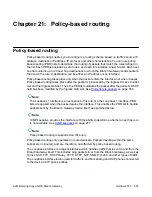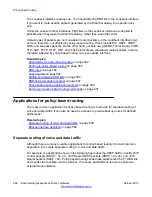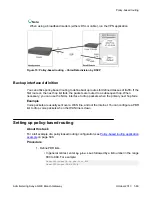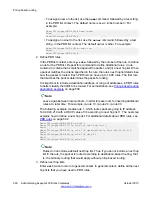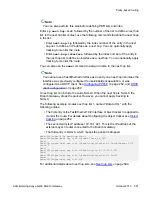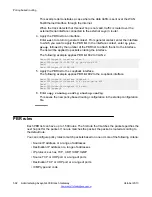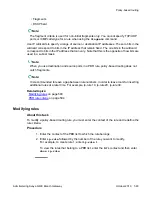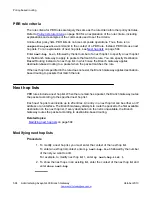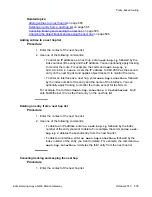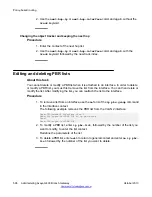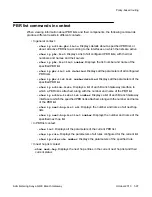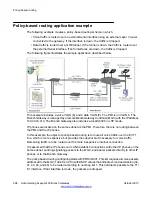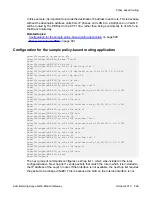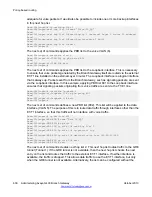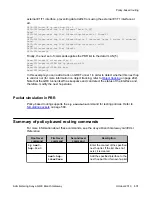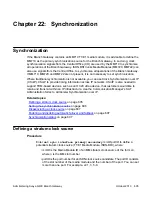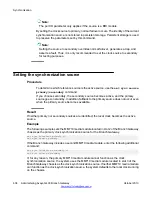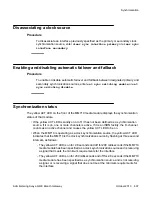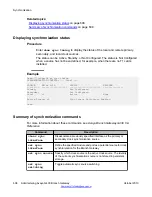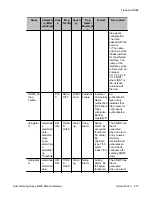
adequate for voice packets. It would also be possible to include one or more backup interfaces
in this next hop list.
Gxxx-001(super)# ip next-hop-list 1
Gxxx-001(super-next hop list 1)#name “Voice-To_HQ”
Done!
Gxxx-001(super-next hop list 1)#next-hop-ip 1 <external Layer 3 router IP address>
Done!
Gxxx-001(super-next hop list 1)#next-hop-interface 2 Null0
Done!
Gxxx-001(super-next hop list 1)#exit
Gxxx-001(super)#
The next set of commands applies the PBR list to the voice VLAN (6).
Gxxx-001(super)# interface vlan 6
Gxxx-001(super-if:VLAN 6)# ip pbr-group 801
Done!
Gxxx-001(super-if:VLAN 6)# exit
Gxxx-001(super)#
The next set of commands applies the PBR list to the Loopback interface. This is necessary
to ensure that voice packets generated by the Branch Gateway itself are routed via the external
E1/T1 line installed on the external Layer 3 router. The Loopback interface is a logical interface
that is always up. Packets sent from the Branch Gateway, such as signaling packets, are sent
via the Loopback interface. In this example, applying PBR list 801 to the Loopback interface
ensures that signaling packets originating from voice traffic are sent via the T1/E1 line.
Gxxx-001(super)# interface Loopback 1
Gxxx-001(super-if:Loopback 1)# ip pbr-group 801
Done!
Gxxx-001(super-if:Loopback 1)# exit
Gxxx-001(super)#
The next set of commands defines a new PBR list (802). This list will be applied to the data
interface (VLAN 5). The purpose of this is to route data traffic through interfaces other than the
E1/T1 interface, so that this traffic will not interface with voice traffic.
Gxxx-001(super)# ip pbr-list 802
Gxxx-001(super-PBR 802)# name “Data_To_HQ”
Done!
Gxxx-001(super-PBR 802)# ip-rule 1
Gxxx-001(super-PBR 802/ip rule 1)# next-hop list 2
Done!
Gxxx-001(super-PBR 802/ip rule 1)# ip-protocol tcp
Done!
Gxxx-001(super-PBR 802/ip rule 1)# destination-ip host 149.49.43.189
Done!
Gxxx-001(super-PBR 802/ip rule 1)# exit
Gxxx-001(super-PBR 802)# exit
The next set of commands creates next hop list 2. This next hop list routes traffic to the GRE
tunnel (Tunnel 1). If the GRE tunnel is not available, then the next hop list checks the next
entry on the list and routes the traffic to the external E1/T1 interface. If neither interface is
available, the traffic is dropped. This allows data traffic to use the E1/T1 interface, but only
when the GRE tunnel is not available. Alternatively, the list can be configured without the
Policy-based routing
600 Administering Avaya G430 Branch Gateway
October 2013
Summary of Contents for G430
Page 1: ...Administering Avaya G430 Branch Gateway Release 6 3 03 603228 Issue 5 October 2013 ...
Page 12: ...12 Administering Avaya G430 Branch Gateway October 2013 ...
Page 246: ...VoIP QoS 246 Administering Avaya G430 Branch Gateway October 2013 Comments infodev avaya com ...
Page 556: ...IPSec VPN 556 Administering Avaya G430 Branch Gateway October 2013 Comments infodev avaya com ...


